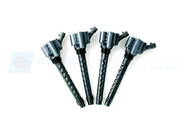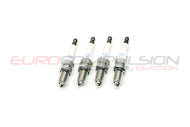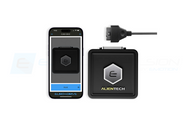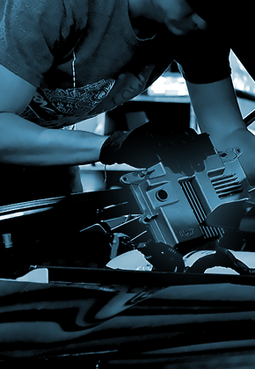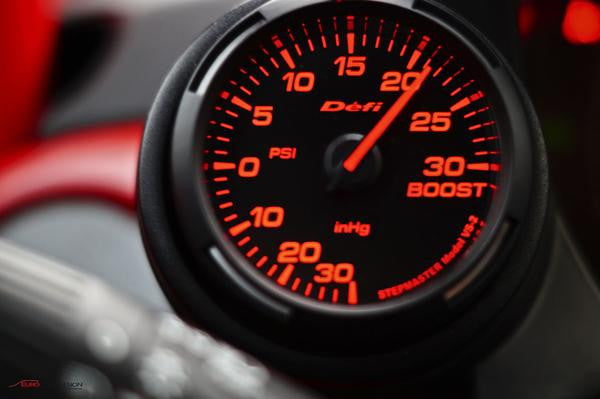
Introduction:
The intention of this article is to allow the reader to get a full understanding of how boost is regulated in the new Fiats, and to understand why Fiat chose to set it up the way they did. This should aid people in diagnosing problems, understanding the various tuning options out there, and even allow those DIY-selfers to do a certain amount of self tuning if desired.
We are going to start off with some fairly basic stuff, and progress to some more advanced concepts. I know that some of this is elementary for a lot of our customers, but I encourage you to read the whole article anyway and not to simply skip ahead if for no other reason than to follow me on the definition of terms so we are all reading the same sheet of music. In order to keep this article a reasonable length, I will be simplifying certain things, so please keep that in mind. I am not writing an engineering term paper. This is just an article to help out fellow enthusiasts and it’s written from that standpoint. I am not going to start every sentence by saying “all other things equal”, or other disclaimers needed to make certain things 100% accurate, you will just have to read this with some common sense.
How a turbocharger works, short and simple version:
Let’s have a quick review of just how the turbocharger works. It has an exhaust driven turbine which spins when exhaust flows through it. It’s a lot like a pin-wheel children blow on to make spin. The turbine is attached via a shaft to an air compressor wheel. So, when the turbine spins, it spins the compressor, and once it gets spinning fast enough we have boost.
Here is a nice drawing from Garrett. This is a generic picture, but with the exception of the bearings and lack of liquid cooling, it’s pretty much just like the 1446 turbo our cars use.

What is boost? Boost is air pressure in the intake manifold above ambient pressure. On a normal day we have about 14.7psi of air pressure all around us, so in this case 14.7 is ambient. Now if we force enough air into the intake manifold so that we have 19.7psi we then have 5 pounds of boost. That 5psi represents about 1/3 more air molecules in the intake manifold that allows us to combust about 1/3 more fuel which will give us pretty close to 1/3 more power compared with full throttle and zero boost. As a general rule, within certain limitations an increase in boost gives a near equivalent increase in power. For example with no boost but at full throttle we get about 14.7psi at the intake manifold. If we add 15 pounds of boost we will essentially double the pressure, thus double the number of air molecules and double the power! (due to pumping losses in the real world it normally takes about 17psi to double the power).
Of course to generate boost, the turbo needs a certain amount of exhaust flow. Below a certain RPM level called the “boost threshold” there isn’t enough exhaust to spin the turbo fast enough to make any boost. There are a lot of factors that effect that, but for this discussion let’s say it’s 2000rpm. That means below 2000rpm you don’t get any boost. However once you hit 2000rpm, now you have enough exhaust for a little bit of boost. That little bit allows more fuel to burn, thus gives more exhaust, thus spins the turbo faster and so on. This means once you reach the boost threshold, you can get full boost very quickly past that point.
Once you are above the boost threshold, delays in boost between your right foot’s input and when the boost starts is called “lag”. In the cars we are dealing with, lag is really minimal and when most people talk about it, they are really describing either boost threshold, or lack of throttle response, and not actually turbo lag.
Turbocharger Control, Older Style:
If you are planning on modifications which change the amount of boost, it’s very important to understand how the turbo is controlled in this car. I see a lot of people replacing parts they don’t need to replace to solve “problems” that are designed in features. Many times when they do have an actual issue, they try to solve it by replacing the wrong parts. This includes the dealers. So it’s a good idea to try and understand how it all works.
We know the turbocharger is driven by exhaust flow. We have to have some way to regulate the exhaust flow through the turbine. If we don’t then as the engine makes more boost, it will make more exhaust, then more boost and so on until it blows up! Actually such turbo systems do exist, and they either use a really tiny turbo that can’t blow anything up, or rely on the driver/pilot/operator to watch the boost gauge and not advance the throttle past the point where boost reaches redline. No car built today uses such a system.
Most modern turbocharged cars, including newer Fiats regulate turbocharger speed, and thus boost with a wastegate that bypasses exhaust around the turbine.
This picture shows a wastegate in the closed position thus forcing exhaust through the turbine to force it to spin faster.

Let’s go back in time for a moment and look at how turbochargers were controlled in the past.
Starting in the late 1970’s and for almost 20 years just about every turbocharger was controlled the same way. They used a boost activated wastegate to bypass exhaust around the turbine. This has the effect of slowing down the compressor and thus lowering boost. The wastegate was moved by a wastegate actuator. The actuator was simply powered by boost. They ran a hose from the boost side of the turbo system to the actuator. When boost pressure was high enough to overcome the spring pressure in the actuator, it opened the wastegate and slowed the turbo. This works pretty well. The wastegate stays fully closed until target boost is reached and then holds boost there by opening the wastegate. Boost adjustment was made by altering spring tension in the actuator.
Here is a simplified Diagram of one of these early systems. In this example at full throttle once boost threshold is reached this system will maintain 10psi.

If we drove a car using this old style boost control system and graphed the boost it would look like this.

If you were driving the car we are using in this example, and one day you noticed boost was now dropping off, say above 5000rpm, that would mean that something has gone wrong. Either the actuator spring adjuster has loosened up and misadjusted itself, a boost leak has developed, or something else has gone wrong. With these old school systems failure to hold boost meant something was wrong.
Turbocharger Control, Newer Style
Now we are going to skip a generation of boost controllers, and jump ahead to what’s actually in the modern Fiats.
The modern Fiats have a very different system for controlling boost. They still have a wastegate, and a wastegate that’s actuated by pressure, but they have added a lot more. Fiat wanted the ECU to be able to control boost. Before we get into how it works, let’s consider why they wanted this.
Most cars today run more boost in the mid range than they do at high RPM. Why? Because they can use more boost in the mid range within certain safety parameters. Modern boost control systems allow manufacturers and tuners to run more boost in the mid range and take advantage of the extra power we can get there. Every single new turbo car I have driven does this, and most aftermarket tunes from the top tuners do as well.
This means it’s absolutely normal for boost to “drop off” at higher rpm. The problem is that a lot of us are looking at that the wrong way. It’s not so much a drop off, as it is a bump in mid range power. Think of it this way. If we are limited by component durability to 12psi at 6000rpm, but we can have the same margin of safety with 16psi at 4000rpm you would want that extra power at 4000 wouldn’t you?
Let’s take the old style car we talked about earlier and put a modern boost control system on it and graph the boost. The old system goes to 10 and stays there, the new one goes to 16 and then drops back down.
In other words, both of the two configurations graphed below have the same level of safety, and both have the same amount of boost at high rpm. Which one would you rather drive? I’ll take the one with the boost “drop off” any day!

I can’t stress enough that a drop off in itself is not a bad thing. Most new cars are programmed this way, and for some pretty good reasons. Just to reinforce this, let’s look at some Mitsubishi Evo boost curves, stock and tuned. The stock curve peaks at about 18.5 and drops to 11. The aftermarket tunes have similar shapes although they drop less (which is generally how I like to do it, I like to keep the drop, but flatten it out some).

I could show examples of this all day long, but I’ll just put up one more from a Cobb Tuned Subaru. Note their tune peaks at 19psi and drops to about 13.5. The dashed line is showing the boost levels.

I can’t stress this enough, in a modern car, the boost curve is normally a curve at both ends of the graph. In 1982 that wasn’t true, even in 1992 it wasn’t usually true, but today it is. We can vary the boost to increase mid range power without making sacrifices in reliability, so why wouldn’t we? Fiat knows this, so does Mitsubishi, Subaru, Alfa Romeo, and the others.
In the case of our FCA vehicles. They switch between multiple boost maps. All have drop offs, some drop off more than others. The best performing map, and the one it runs more often than the others peaks at about 18psi and drops to about 11-12psi by about 6000rpm. Some have seen this drop off as a problem and have taken to swapping in aftermarket components to try and eliminate it. You can actually reduce the drop off with a stiff enough spring in the boost actuator, but it will cause other issues, which is something we will be talking about more later in this article.
The Fiat 500T does not run the Abarth’s “Sport Mode” maps. In fact the lack of these maps is exactly what makes the 500T a 500T and not an Abarth in terms of power. The 500T has some boost maps that, in my opinion are terrible, and are designed to hamstring the car and make tuning via signal control (more on that later) difficult and less effective. The most frustrating map is the one we at EC call the “double humper” (there is actually more than one double humper).
I graphed one of the Double Humper Maps. Note, this graph is based on the actual graph in the ECU. In other words this is what the ECU is commanding, not boost actually seen which is a little different. Also, it’s a little off due to rounding errors and scale, but it’s close enough for what we are doing here.

So how is boost controlled in our cars?
The new Fiats use an interesting mix of new and old tech to control boost. The components involved are the ECU, Boost Solenoid and associated hoses, Wastegate Actuator and wastegate, and the electronic throttle. The ECU references two boost sensors when the engine is running to monitor and adjust boost.
The main change from the old style systems is that there is now an ECU controlled boost solenoid located between the boost source and wastegate actuator as seen in this picture.
Generic Diagram:

The old style boost control system we talked about earlier relied on spring and boost pressure to regulate boost and could only regulate it to one number which in the case of our example was 10psi because it has a 10psi spring in the actuator. The new system uses a relatively weak spring, so it can run less boost if it wants. Additionally the spring pressure can no longer limit max boost because the solenoid will prevent air from reaching it and opening the wastegate unless commanded by the ECU. If the ECU wants more boost, it closes the solenoid and spring pressure will hold the wastegate closed. If it wants less boost, it will open the solenoid and by doing so can decrease boost down to the whatever value the spring is.
Now, if you use a spring with a lot more tension it may cause the ECU some confusion. Let’s say your spring is a 15psi spring and the ECU calls for 12psi. It’s not going to be able to get 12psi and hold it via wastegate control because when boost drops below 15psi there won’t be enough force available to open the wastegate. However, in that case, the ECU has another trick up its sleeve.
The ECU can also pull out boost by closing the electronic throttle, which it will do. Normally it controls boost by adjusting turbine shaft speed by adjusting the wastegate. However sometimes it can’t do that. Sometimes it needs to cut boost suddenly. Or there could be something wrong with the car, for example if the hose comes off the wastegate actuator, it can’t move the wastegate, in which case throttle control would be the most effective way it could cut out boost.
In normal operations the ECU doesn’t use the throttle to pull back boost. Sometimes at high rpm if boost isn’t dropping fast enough it will flick the throttle back for a moment and then advance it again, but unless you are logging the data or watching it with an app, you won’t see it.
If your car has a boost problem, one of the easiest things to check is the throttle. Use one of the popular apps and observe or log throttle position. If it’s not opening to about 87 most of the time when the pedal is all the way down, either the throttle is bad or needs to relearn.
If the throttle checks out OK, the next thing to look at are the hoses associated with the boost solenoid. They are critical, and any leaks will be a problem.
If that’s OK, check the boost solenoid itself. There are numerous youtube tutorials on how to do that. It’s easy and with a 9 volt battery and a couple wires you can check it out. Also make sure the dang thing is plugged in.
If that’s OK, look at the wastegate actuator and make sure it moves smoothly and start looking for boost leaks.
If you made it this far in this article you should have a pretty good idea of what’s normal behavior for your Abarth or 500T in terms of boost. If it’s acting up, you should have decent ideal of what to check before you spring for a shiny new and expensive turbo.
Increasing Boost
One way to increase boost in the new Fiats is via a method we at EC call signal boost control. Signal boost control is used by all the current tuner boxes, including the Euro+Drive Lite system.
In principle, it's simple. When the engine is running the ECU references two boost sensors and uses that data to decide to open or close the wastegate. If it wants 15psi and it’s seeing 18, it pulses the boost solenoid to let more air pressure reach the wastegate actuator and open the gate. One boost sensor is before the throttle, and the other is after the throttle. As long as the throttle is fully open the two read essentially the same.
These map sensors send 0-5 volt signals. More voltage means more boost.
So how does signal boost control work? It’s very simple in principle. The voltage signal from the boost sensors to the ECU is intercepted and altered. For example, 18 psi will read as about 3.6 volts. In this example we want 20psi, so we will knock that voltage down as it’s on the way to the ECU to about 3.4 volts. So when the engine is actually getting 18psi, the ECU will only see 3.4 volts. Then it will increase boost until it sees 3.6, which in this case will ACTUALLY be 3.8 and we will have darn near 20psi in the intake manifold.
Tuning Boxes aka piggy backs
At this point you might be wondering, why can’t I just go down to Radio Shack ask some guy what 65 cent resistors I need to knock voltage down by .2 volts or whatever I am going for and wiring those in? I mean finding the correct wire from the boost sensors is pretty easy. There are only three of them on one sensor, and five on the other, and a couple mins with a volt meter will show which one I need to splice into. Well, you can’t do this. If you do, you will get a check engine light and various codes almost right away.
Fiat put a self test function on this car partially to check for this, but also to test the functioning of the two boost sensors. Before the engine is running, the ECU will compare the values from these two sensors and an ambient sensor and if they are not all the same, the ECU will throw a bitch fit and put up some codes.
So how do the various tuner boxes get around this? There are two methods in use, and other possible methods. The key is that the ECU can’t do this self test once the engine is running. The engine has to be off for all three sensors to be looking at the same pressure values. So they way most modules avoid this problem is by not activating unless they see a certain amount of boost. This prevents them from altering the signals unless there is a pre determined amount of boost present, and thus the engine must be running.
Euro+Drive Lite is a little different in this area? We not only set the boost threshold where the system activates, we can set an RPM point as well. That RPM point is also adjustable via the self tuning option.
On the subject of reading RPM, that’s actually a big deal. The boxes that don’t read RPM can only move the ENTIRE boost curve up or down, they cannot change the shape of the curve. In other words, if they want to add 2psi, they have to add it at all RPM levels above the boost threshold.
This of course means that all these boxes are pretty similar, one may move the whole curve slightly higher or lower, but they don’t vary by all that much. I want to say that of these boxes I like the RR U3 the best. I have spoken with the guy who designed it, he knows what he is doing and put some real effort into that box, and it’s specs are darn good. It’s still limited by the fact that it can only shift the whole curve up or down. I also like the Chipbox, but I haven't actually tried it yet.
This chart shows an approximation of boost levels on a 500 Abarth. The typical “module” shown in the graph shows how the entire boost curve is moved up, but there is no change to the shape of the curve. The “TUNE” line shows how we can change the shape of the boost curve with either Euro+Drive Lite, or Euro+Drive.

At the time of this writing Euro+Drive Lite is one of only two piggy back type devices that can alter the shape of the boost curve on the Fiat 1.4 turbo. It's the only one that can alter it in 100rpm increments and over such a wide range of boost values. It's also the only one that offers a true self tuning option. In short I think it's the best piggy back device ever offered for this engine.
Euro+Drive from Eurocompulsion

All piggy backs have limitations of some kind. So it's peferable for us to use an ECU flash tune when possible. At the time of this writing, we can do this for the 2012 and 2013 Fiats, and certain other years for the 500L.
EC’s excellent Euro+Drive system doesn’t use signal boost control. It's a true ECU flash tune. It replaces all the boost maps (or fuel maps or whatever maps we want) with maps of our own specs. This greatly improves and simplifies things. The double humper is replaced so we just don’t have to deal with it. The ECU never gets confused about how much it should be pulsing the boost solenoid because that’s always in harmony with the target boost levels on our maps. We can make the map do whatever we want, and there is no wiring harness to worry about.
In short, Euro+Drive gives us full control over boost, and we are only limited by the physical limitations of the turbo itself and other hardware. This will become even more important with turbo upgrades.
I want to go over some other Euro+Drive advantages. We never really did this before, and while some of these things don’t relate directly to boost, they are related at least indirectly because as boost changes so do fuel and timing requirements.
What about ignition timing? Euro+Drive offers full control over ignition timing. We can literally do anything we want with it. For example with Euro+Drive we can alter timing as it relates to coolant temperatures. If the car is starting to overheat, we can retard the timing a little.
What about fuel control? This is something that comes up a lot. It seems few people understand it. Euro+Drive offers full control of fuel within the limitations of the installed fuel injectors (if bigger injectors are needed Euro+Drive supports that). The tuner boxes do allow for adequate fuel control within certain parameters. However they can only add fuel with boost as needed to maintain the stock air fuel ratios. I want to stress that within the boost levels they provide the stock AFRs work great with the various tuner boxes, there is NO problem there. The potential problem arrives at higher power levels, and at the levels Euro+Drive is able to handle it. Even at lower levels where it’s not strictly required the ability to alter the AFRs has enables us to get extra power with no extra risk.
One big factor that a lot of users seem to like is Euro+Drive’s ability to adjust the throttle response. That’s proven to be a popular (and zero cost) option. It’s something that the other products discussed here don’t support without the purchase of additional hardware.
In short, Euro+Drive is simply superior in every way to the tuner boxes, including Euro+Drive Lite.
I really want to thank Chris at EC for helping to make Euro+Drive happen. He took the risk, and I don’t think it was an easy decision because from a business standpoint, he already had a good chunk of the tuning market, but he had the foresight to see the direction we needed to go, and I think the whole community is better off because of it.

